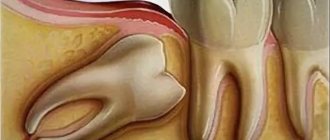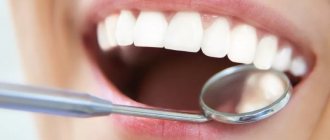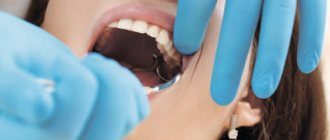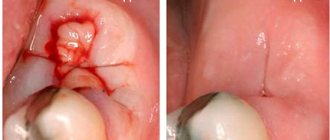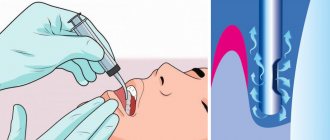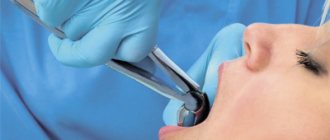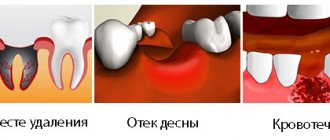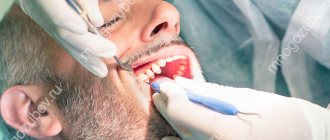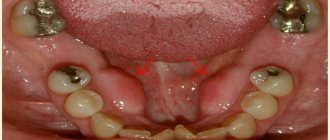People with dental problems often wonder whether a lymph node can become inflamed due to a tooth. Doctors have repeatedly warned that inflammatory processes in the oral cavity often lead to enlarged and painful lymph nodes. If a person experiences these symptoms, they should immediately make an appointment with a dentist. The doctor will treat the diseased tooth, after which the work of the inflamed lymph node will normalize and it will no longer cause discomfort.
Teeth and inflamed lymph nodes: what is the relationship? Symptoms of pathology, causes, treatment methods
When inflammation of the lymph nodes occurs after tooth extraction, not everyone is ready for such a turn of events. People who have not gone through the extraction procedure (removal) are even less likely to expect an inflammatory process in this important system for the body. However, this phenomenon is not uncommon. At the same time, doctors often find a connection in it with teeth. Let's look at the nuances of this difficult topic together.
Why does the inflammatory process occur?
As you know, the lymphatic system is a very important component of our body. It prevents various pathogens from entering the blood and internal organs, but it itself is often the first to take the blow due to decreased immunity. Many people know that swollen lymph nodes are often the first signal that a person has some kind of disease in the body. They usually swell shortly before the first symptoms of the disease appear. Their increase may indicate a sore throat, HIV, syphilis, tonsillitis, lupus, measles, scarlet fever, arthritis and many other pathologies.
This is interesting! Scientists have found that in the human body there are more than 400 lymph nodes (they are located in small groups) and about 2 liters of lymph that passes through them. The greatest concentration is on the neck and head, under the jaw and chin, under the arms and in the groin. Each group is responsible for the well-being and protection of nearby organs.
However, not everyone knows that inflammation in this important system for the body often occurs due to dental pathologies. This means that the infection gets there from a nearby area, in this case, from the oral cavity, where a large number of different bacteria live. Naturally, staphylococci, streptococci and other harmful as well as beneficial bacteria are constantly present in the mouth, and this is normal. But the problem arises only if microbes multiply rapidly and pathogenic microflora begins to predominate. Why is this happening? Read on.
Prevention
To strengthen the immune system, it is recommended to consume citrus fruits
Each person can prevent the re-development of cervical lymphadenitis due to dental diseases if he follows simple tips:
- In case of lesions in the oral cavity, rinsing with saline solution is required.
- It is necessary to include ginger tea in your diet.
- You should carefully monitor your oral hygiene.
Experts recommend consuming citrus fruits, natural products and honey more often. They help strengthen the immune system and improve the functioning of the lymph nodes.
Main dental problems leading to pathology
- abundant accumulation of bacterial plaque on and under the gums,
- gingivitis and periodontitis,
- advanced caries, pulpitis, periodontitis,
- purulent-inflammatory processes: flux, fistula, abscess, festering cyst and granuloma, osteomyelitis, phlegmon,
- damage to the oral mucosa by stomatitis, especially in acute and recurrent [1] varieties caused by the herpes virus or Candida fungus,
- glossitis of the tongue,
- poorly installed, old fillings and crowns under which inflammation has developed,
- long-term lack of sanitation of the oral cavity: during the sanitation process, the doctor applies a set of measures aimed at eliminating all dental pathologies.
This is interesting! The submandibular lymph nodes are responsible for the condition of the nose, throat, teeth and ears. If they are the ones that become inflamed, then you need to look for pathology in the listed organs, and to eliminate the problem, contact a dentist (in 60% of cases, dental pathologies are detected) or an ENT doctor.
Location of lymph nodes
Lymph balls are separate groups, each of which is responsible for the safety of a specific part of the body. Submandibular groups (6-8 pieces) are located below the jaw near the facial vein and salivary gland.
These organs are a kind of checkpoints of the lymphatic system - it is in them that pathogenic microorganisms and harmful substances circulating in the lymph are filtered and neutralized by the forces of leukocytes.
The lymphatic system of a healthy person does not cause him any discomfort. The normal diameter of a lymph node averages 1 cm and ranges from less than 0.5 cm for ulnar nodes to 1.5 cm for inguinal nodes. Enlargement of nodes above this limit is a symptom of many infectious, endocrine, tumor and autoimmune diseases.
Also a deviation from the norm is the pain and immobility of the nodes - normally these organs are palpated without discomfort and move freely under the skin when pressed.
Teething and enlarged lymph nodes
The problem is typical mainly for children whose first milk units are being cut. Babies have a weak immune system, and during this period it weakens even more, since the body is under a serious load. Often, teething itself is very difficult, accompanied by alarming symptoms (moodiness, cough, fever, runny nose) and even the addition of bacterial and viral infections.
This pathology does not always escape adults. For example, when a wisdom tooth is cut and the submandibular lymph node increases in size, this is a fairly common occurrence. The third molars pass through the jawbone, and this process takes a long time, plus it is often associated with disturbances. “Sages” can compress and touch the branches of the trigeminal nerve, rest against neighboring elements of the row and destroy them. Their eruption may be accompanied by a decrease in immunity and an increase in body temperature, to which all the defense systems of our body react very sensitively.
Sometimes growth pathologies of the “eights” lead to the development of a purulent-inflammatory process such as pericoronitis. The problem arises when a kind of hood forms between the gum and the not fully erupted “figure eight”, where bacteria and food debris get trapped.
On a note! If your wisdom tooth hurts and the lymph node is swollen, then the symptoms may indicate damage to the third molar by caries, pulpitis, or periodontitis. If the cheek is also swollen, then, most likely, gumboil has developed.
Why does the problem occur after tooth extraction?
Let us list the main reasons why nodes become swollen after tooth extraction.
1. The body's reaction to surgery
It is not uncommon for a lymph node in the neck or under the jaw to slightly increase in size immediately after tooth extraction. Some experts believe that after surgery such a reaction is quite natural, because the body has activated all its forces in order to quickly cope with the physiological trauma inflicted on it.
If you have removed a wisdom tooth and then felt an enlarged lymph node in your neck, then you should not panic ahead of time. Procedures for extracting “eights” are always complex, large-scale and quite traumatic. Therefore, after them, a non-infectious inflammatory process almost always occurs, accompanied by a number of characteristic symptoms: increased body temperature, pain, limited jaw mobility and the inability to open the mouth wide, general weakness.
The procedure was carried out against the background of a purulent-inflammatory process
Typically, patients come for extraction (removal) if there are advanced dental diseases in the mouth that cannot be restored. Often the operation is performed urgently, against the background of an acute inflammatory process. Therefore, enlarged lymph nodes after tooth extraction with periodontitis, gumboil, fistula, cyst, granuloma are a common story. After all, the inflammatory process in this case had already been going on for some time. And it does not go away immediately after eliminating the problematic element; you still have to fight it by taking antibiotics and other medications, lotions, antiseptic rinses, and physiotherapy.
Extraction complications occurred
If several days have passed after tooth extraction, and you notice that the lymph node under the jaw hurts and is inflamed, this may indicate the development of the following complications of extraction:
- alveolitis: this is where it all begins. This is an inflammation of the socket that occurs due to a medical error or due to a violation of the postoperative regimen on the part of the patient. Actually, the complications that we will list below appear because the patient develops alveolitis, or tries to cure the disease on his own and does not seek medical help,
- flux, abscess, phlegmon, osteomyelitis.
Possible complications
If the lymph nodes become inflamed and there is no treatment, then there is a high risk of developing the following complications:
- Phlegmon. Accompanied by severe swelling of the lymph node. The inflammatory process spreads throughout the neck and spreads to nearby lymphatic structures. The skin acquires a bluish tint, the pain syndrome worsens, and the patient loses the ability to make motor movements of the jaw. Body temperature can increase to 40 degrees.
- Inflammation of surrounding tissues. When bacteria actively multiply, the infectious process spreads. This gradually leads to the breakdown of soft tissue.
- Tumor degeneration. Inside the lymphatic structure, conglomerates form, which gradually merge with each other.
Signs of pathology
If there is no pathology and the person is healthy, then the lymph nodes are quite difficult to palpate. But if there are problems in the body, their condition changes. At first, the inflamed areas only swell slightly and increase in size, which becomes noticeable upon palpation. The pathology is not accompanied by any other signs at the initial stages.
If, due to dental problems or after tooth extraction, the lymph node hurts, then it means that the person has started the underlying disease, against which he may have developed lymphadenitis. What is this? This is just inflammation of the lymph nodes. Let us list the symptoms of the pathology.
- Swelling and enlargement of the areas under the jaw, chin and neck. When you feel them, you can find lumps and even lumps. In rare cases, the lymph node behind the ear may also increase in size, for example, if there are eruption pathologies or complications arise after the removal of a wisdom tooth.
- Discomfort when opening the mouth, chewing and swallowing food, when swallowing saliva and drinking liquids (soups, drinks). Pain when pressing on inflamed and enlarged areas. In later stages of the disease, pain can spread to the neck, head, and radiate to the jaw and throat.
- Increased body temperature. The more the disease progresses, the higher the temperature. The thermometer can reach 40°C.
- The appearance of general malaise and weakness, chills, insomnia.
Symptoms of the disease
Inflammation of the lymph nodes in dental pathologies occurs gradually. The inflammatory process causes the following symptoms:
- Compaction and enlargement of lymph capsules.
- The appearance of a dense tubercle that moves when pressed.
- Pain on palpation, which can radiate to the ear and neck.
- General malaise appears and sleep deteriorates.
- Body temperature rises.
Further, the clinical picture progresses. The lymph node increases in size and the skin over it becomes hyperemic. When moving, the pain intensifies. Chewing and swallowing food becomes impossible. During palpation, severe pain and discomfort occurs. Temperatures increase, and severe swelling appears at the site of the inflammatory process. The level of leukocytes in the blood increases.
Photo: cervical lymphadenitis
From the onset of the pathological process to the transition of the disease to an acute form, only three days pass. The clinical picture changes quite dramatically. Swelling can quickly spread throughout the neck. The person becomes irritable and lethargic, stops sleeping and eating normally.
Dangerous consequences of pathology
If you do not promptly treat the underlying problem that caused the swelling and enlargement of the lymph node, then, as mentioned above, you will develop lymphadenitis.
Usually, the submandibular form of the disease occurs first, but in the absence of therapeutic measures, the infection descends lower, and then the cervical type of pathology develops. That is, the lymph nodes in the neck become inflamed, which poses a serious threat to life and health. For those who do not consult a doctor on time, the body may become severely intoxicated.
From the acute form, the disease passes into the chronic stage, and pus begins to accumulate in the tissues. When the pathology is neglected, there is a risk of developing phlegmon [2], thrombosis, the formation of malignant tumors, as well as a purulent abscess, the contents of which can at any time break into nearby organs, spread through the hematopoietic system, reach the bronchi and respiratory tract, and cause sepsis.
Causes of teething problems
Like teething symptoms, the causes of complications can be grouped into two groups, in order of importance. The first group of reasons includes the following problems that may arise in the expectant mother in the first trimesters of pregnancy:
- Acute respiratory infections and any other disease with a high fever
- Kidney diseases
- Rubella, herpes or toxoplasmosis
- Various toxicoses, especially before the second trimester
- Frequent stressful situations
Many doctors call the risk group, due to which the baby may also experience various complications with teething:
- Rhesus conflict between mother and fetus
- Prematurity
- Previous rickets
- Cardiovascular problems in a child
- Mother's refusal to breastfeed
Professional diagnostic measures
When a lymph node becomes inflamed, you should not hesitate to see a doctor. It is better to start by visiting a dentist, who will examine the oral cavity and send you for an x-ray to obtain information about the presence or absence of hidden processes and dental pathologies.
Additionally, the patient may need the help of other specialists: an ENT doctor, a therapist, an infectious disease specialist. Be prepared that for a detailed diagnosis you may be referred for urine and blood tests (usually they reveal an increased number of leukocytes), bacterial culture, and ultrasound.
Treatment
If a person has a toothache or is starting to erupt, he will be disturbed by an enlargement of the nearby lymph node. When teething, the development of cervical lymphadenitis is not excluded, which should not be left to chance.
Therapy for an inflamed tooth, gum and lymph node includes taking medications. Only the doctor decides what means to treat the disease. He will also tell you what procedures to carry out after treatment in order to consolidate the result achieved with its help.
The following therapeutic measures can contribute to recovery:
- Sanitation of the oral cavity.
- Rinse with Burov's solution.
- Opening abscesses if present.
- Antibacterial therapy.
- Vitamin therapy.
- UHF.
A surgeon may be needed if the patient needs to have swollen lymph nodes cleaned.
Measures to eliminate the problem
Dental treatment
In order for the lymph nodes to return to normal, it is first necessary to get rid of the main problem that caused their enlargement and inflammation. Depending on the pathology, the dentist can perform the following manipulations:
- cleaning teeth from plaque and tartar,
- treatment and filling of root canals,
- surgical opening and drainage of ulcers (with flux, abscess),
- cleaning the socket (for alveolitis),
- tooth-preserving operations: cystectomy and cystotomy, resection of the root apex for cysts and granulomas,
- replacement of unsuitable fillings and crowns.
After treatment of dental pathologies, the lymph nodes do not disappear immediately. Swelling may persist for the next 7-10 days. In order for the patient’s condition to normalize faster, he is additionally prescribed physiotherapy (for example, UHF therapy) and prescribed medicinal support.
“I once had a tooth removed with periodontitis on the lower jaw. A few days after this, I noticed that the lymph node was a little swollen and painful. I didn’t want to go to the dentist again, I hoped that it would go away on its own. Then the hole healed safely, but the swelling under the jaw sometimes appeared again. In general, I started this case, and when more frightening symptoms appeared, I ran to the doctors. I was told that there was pus inside the lymph nodes and it needed to be cut out. There was no choice, I had surgery, then took antibiotics. Now I regret that I didn’t go to the clinic right away...”
S. Tsareva, review from gidpozubam.ru
Drug therapy
The doctor will prescribe medications to take at home. In case of inflammation of the lymph nodes, as well as in advanced dental diseases, a course of antibiotic therapy is prescribed for 7-10 days. The patient is also recommended ointments for applying external lotions and applications to the affected areas. Additionally, immunostimulants and multivitamin preparations are prescribed, which must include vitamin C to boost immunity.
Symptomatic treatment is also prescribed. For fever, antipyretics are taken, and for pain, painkillers are taken.
Inflammation of the gums due to gingivitis and periodontitis –
With gingivitis, the patient complains of swelling, redness or cyanosis of the gingival margin and interdental gingival papillae, bleeding and soreness of the gums when brushing teeth, and bad breath (Fig. 1-2). The development of gingivitis is associated with a microbial factor, i.e. when, against the background of not very good oral hygiene, soft microbial plaque accumulates in the area of the necks of the teeth and hard tartar forms.
Pathogenic bacteria from soft microbial plaque and hard tartar produce toxins and inflammatory mediators, which cause inflammation in the gums. Please note that with gingivitis, inflammation affects only the gingival margin and is not accompanied by destruction of the periodontal attachment or bone tissue around the teeth. But if at this stage the causative factor of inflammation (microbial plaque and tartar) is not removed, then over time the destruction of the dentogingival attachment, the bone tissue around the teeth, as well as the periodontal attachment of the roots of the teeth to the bone occurs. All this already indicates the transformation of gingivitis into “chronic periodontitis”.
Inflammation of the gums (chronic periodontitis) –
Periodontitis is still characterized by all of the above symptoms of gingivitis + over time, tooth mobility appears, during periods of exacerbations, purulent discharge may be released from under the gums, the roots of teeth gradually become exposed, and also in severe stages of periodontitis, fan-shaped divergence of teeth occurs (Fig. .5-6).
Inflammation of the gums: treatment for gingivitis and periodontitis
If the patient complains of generalized inflammation of the gums, treatment for gingivitis and periodontitis begins with the procedure for removing dental plaque, and immediately after this a course of anti-inflammatory therapy is prescribed. Bacterial plaque and tartar can only be removed from teeth by a dentist, and usually ultrasonic teeth cleaning is used for this (Fig. 7-8). However, the course of anti-inflammatory therapy itself can be carried out at home, and for this, the dentist will prescribe you a course of antiseptic rinses and gel applications to the gums.
Ultrasound removal of dental plaque: photo
ANTI-INFLAMMATORY THERAPY SCHEME:
Let's now see how to treat gum inflammation with medication, and first of all, antiseptic rinses and gel applications to the gums will help us with this. But you must understand that if you decide to neglect the stage of removing dental plaque at the dentist and start with drug therapy, this will only temporarily suppress the symptoms, but will not stop the destruction of the attachment of the gums to the teeth (which will simply be more asymptomatic).
1) Antiseptic rinses - drug treatment of gum inflammation usually lasts - 7-8 days for gingivitis and 10 days for periodontitis. We will need an antiseptic solution for rinsing the mouth (usually chlorhexidine is prescribed), as well as an anti-inflammatory gel for the gums. Gum treatment is carried out 2 times a day (morning and evening), and it is important to do it only after meals and subsequent oral hygiene. And precisely in this sequence, and not vice versa!
Thus, in the morning you should have breakfast, brush your teeth and then rinse your mouth with an antiseptic chlorhexidine solution. To do this, you must take 10 ml of solution into your mouth (about 1 sip) and, without spitting, rinse your mouth for a full 1 minute. Next, spit out the solution and under no circumstances rinse your mouth with water! An important issue is the effective concentrations of chlorhexidine, and you can read more about this at this link (this article provides reasoning and links to clinical studies).
With gingivitis, everything is quite simple, and if you have removed plaque from your teeth at the dentist, then, in principle, the usual inexpensive solution of 0.05% chlorhexidine, which is sold in any pharmacy for 30-40 rubles, will be more or less effective (although it is considered optimal to use at least 0.12% chlorhexidine). But if we are talking about periodontitis, then the minimum effective concentration should be at least 0.2%. Products containing 0.2-0.25% chlorhexidine are more expensive, for example, Parodontax Extra mouthwash with 0.2% chlorhexidine will cost from 210 rubles per 300 ml bottle.
2) Application of gel to the gums - immediately after rinsing, we need to apply a special anti-inflammatory gel to the gums. The best medicine for gum inflammation for these purposes is Cholisal gel, which copes with inflammation very quickly, but it costs about 470 rubles (per tube of 15 g). At the same time, you will need 1 tube for the course of treatment of gingivitis, and 2 tubes of the drug for the course of treatment of periodontitis. If this is expensive, then you can use Parodontocid gel, which is certainly weaker than Cholisal, but it will work well if you combine it with 0.2% chlorhexidine.
The gel is applied to the gingival margin around the necks of the teeth and interdental gingival papillae using the tip of the index finger. First, it is advisable to apply the gel around the lower teeth, then around the upper ones (note that the gel must be applied not only from the front surface of the teeth, but also from the palate/tongue). The gel will adhere better to the moist mucous membrane if you first dry the gingival margin with a dry gauze swab. It is better to treat the gingival margin from the front surface of the teeth in 2 stages (24stoma.ru).
Those. First, you rub small portions of the gel into the gum margin (using light massaging movements), after which you apply the gel without massage and leave it on the gum. The gel can be applied to the gingival margin from the palate/tongue only once, rubbing small portions of the gel with light massaging movements. Another option for applying the gel is using a thin medical (dental) spatula or applicator. After applying the gel, it is advisable not to drink for at least 30 minutes, and you should not rinse your mouth or eat food for at least 2-3 hours.
Important: during the application of the gel, saliva may be actively released, but it does not need to be accumulated in the mouth or spat out. Saliva should be swallowed as you usually do. In the evening, repeat the treatment in the same sequence (dinner → oral hygiene → antiseptic rinse → applying gel to the gums). And you should do this for 7-8 or 10 days, depending on the type of gum inflammation.
Important:
- With gingivitis, only the marginal part of the gum is affected by inflammation, so the above-mentioned anti-inflammatory course and preliminary removal of dental plaque is quite sufficient to completely stop the inflammation in the gums.
But to prevent inflammation from occurring again, it is very important to maintain proper oral hygiene. Below at the link you can read comprehensive information on the forms of gingivitis and their treatment - → Algorithm for the treatment of gingivitis - For periodontitis , i.e.
when the symptoms of gingivitis are accompanied by tooth mobility, exposure of roots, suppuration from periodontal pockets - just removing dental plaque and the above course of anti-inflammatory therapy will no longer be enough. This may additionally require antibiotic therapy, washing of periodontal pockets, splinting of mobile groups of teeth, as well as surgical treatment methods. Read more about this in the article – → Algorithm for the treatment of periodontitis
